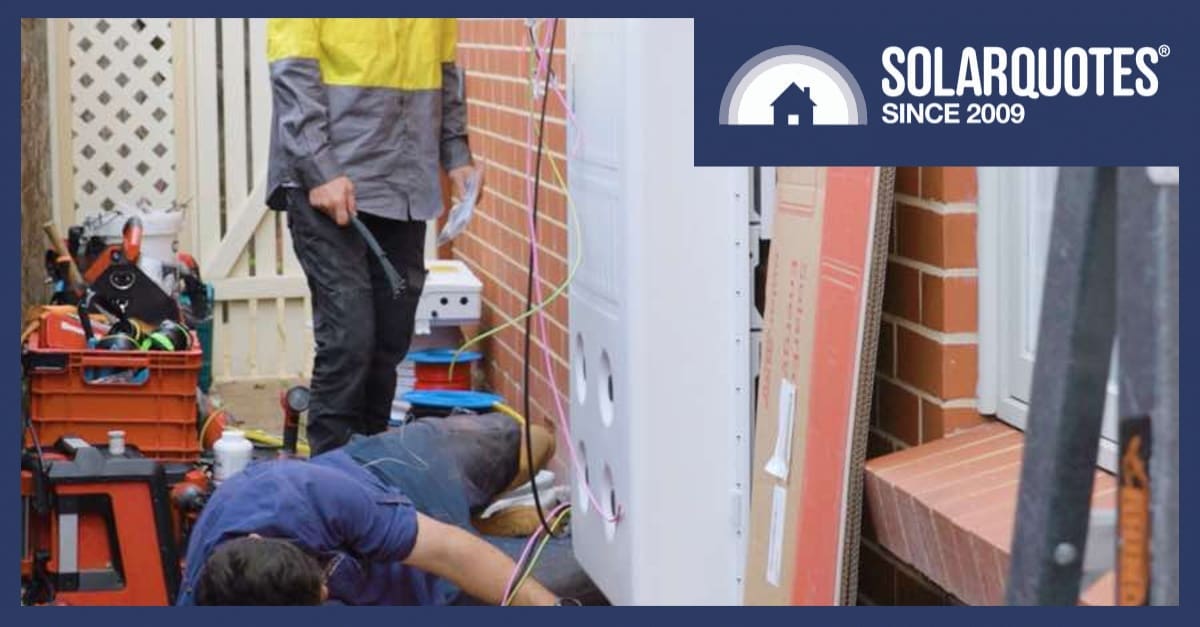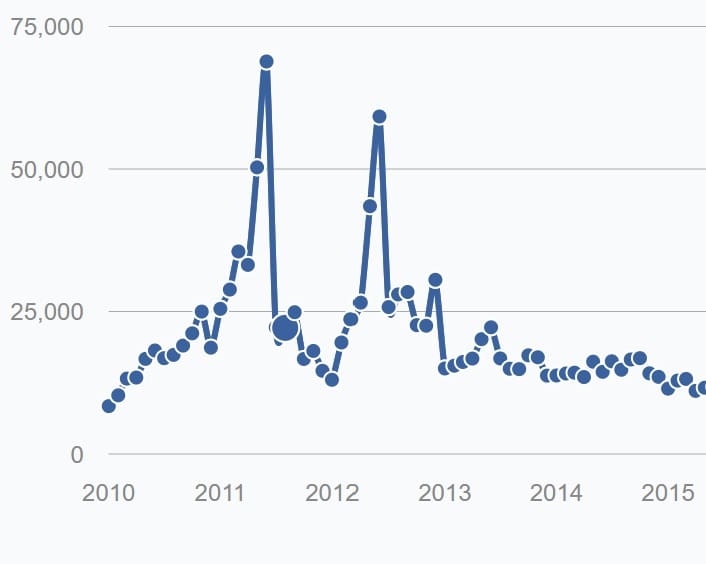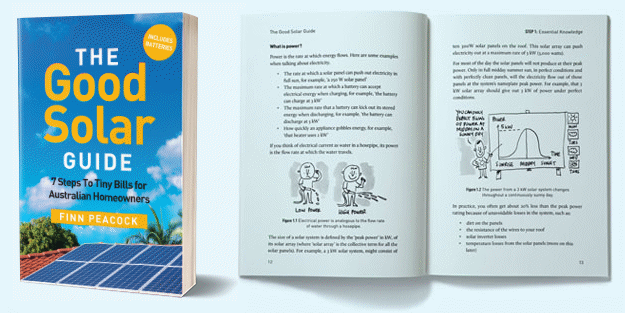 Extraordinary uptake in response to the federal battery rebate means the scheme is likely to chew through its announced $2.3bn funding pool well ahead of schedule. SolarQuotes can reveal that the Albanese government has earmarked additional funding, but this still doesn’t make up the projected shortfall.
Extraordinary uptake in response to the federal battery rebate means the scheme is likely to chew through its announced $2.3bn funding pool well ahead of schedule. SolarQuotes can reveal that the Albanese government has earmarked additional funding, but this still doesn’t make up the projected shortfall.
Since the July 1 start date of the Cheaper Home Batteries Program, homeowners have installed batteries at a blistering pace. Last week, the Clean Energy Regulator (CER) reported 11,536 batteries already completed, at a pace of over 1,000 a day.
The average size of the batteries has also grown to 17 kWh, well up on long-term averages of 10-12 kWh, according to data from solar consultancy SunWiz.
With such a massive response, SolarQuotes analysis indicates that the $2.3bn in announced rebate funding is on track to be exhausted well before the program’s planned 2030 end date.
Battery Rebate Funds Likely To Run Out By 2028
Ronald Brakels, SolarQuotes’ resident fact checker, has crunched the numbers and found that the scheme could run out of money by early 2028 unless adjustments are made.
“If the average usable battery size is 17 kWh and 75,000 are installed over six months with the federal rebate this year, and installations over a year increase by a third so there’s 133,000 in 2026, and then 177,000 in 2027, then funding runs out early in 2028. While the increase in installs I’ve used is generally faster than for solar in high-growth years. there were a couple of years that were just nuts,” he says.
Ronald adds that if the rate of increase in installs isn’t as extreme, the funding won’t run out until towards the end of 2028.
“Last year, in 2024, battery installs were 74,582. In 2025 we have half a year of federal battery rebate. If 50,000 are installed this year with the federal incentive, and the number installs over a year increases by just 25% in 2026 to 125,000, and then by 20% to 150,000 in 2027 and holds steady, and the average installation has 17kWh of usable capacity, the funding will run out towards the end of October in 2028. This assumes all money goes towards batteries. As there are probably other costs, it’s likely to end before then,” he says.
Solar Rebate Also Saw Demand Spikes

Australian rooftop solar installations per calendar month dramatically spiked in the early 2010s in a couple of instances before settling down, according to the Australian PV Institute. Time will tell whether the response to the battery rebate will follow a similar trend.
Ronald says that the pace of solar panel installs under the solar rebate is instructive.
“If we ignore the first few years after big incentives were introduced for solar and look at what was achieved when things settled down and only STCs and modest feed-in tariffs were available, solar could still manage ~25% growth in installations in a some years. Based on that, an end to funding before the end of 2029 seems likely. If the average system size ends up being over 17kWh usable, it will end even sooner,” he says.
Even if demand turns out to be “nuts”, Ronald doubts the scheme will exhaust its funding much earlier than 2028, as he notes there’s a limit to how fast new installers can be trained and qualified.

Labor politicians like Mark Dreyfus (pictured) campaigned hard on its Cheaper Home Batteries Program during the federal election campaign, so the Albanese government would be keen to ensure one of its flagship election promises doesn’t wrap up earlier than planned.
Labor Earmarks Additional $1.2bn For Battery Rebate
SolarQuotes has confirmed that the program’s budgeted $2.3bn is to cover the forward estimates period, which covers the budget year and the following three years through to mid-2029. We can reveal that an additional $1.2bn has been earmarked to see the program through to 2030-31.
However, given that the initial $2.3bn worth of funding is on track to be exhausted by 2028, it looks set to fall short even if just factoring in the forward estimates period.
The federal government is understood to be taking a flexible mindset going forward, viewing the program and expenditure as demand-driven by the uptake under the scheme.
Ronald speculates that reducing the currently generous capacity limit of batteries eligible for the rebate could give the funding a bit more staying power, suggesting that “reducing the number of kWh that can receive the incentive is a fairly obvious way of getting costs under control”.
A solar battery system with a nominal (total) capacity of 5 kWh to 100 kWh is currently eligible under the scheme, but only the first 50 kWh of usable capacity is discounted (read about the difference between usable and nominal capacity here).
The large capacity limit has helped fuel a barrage of deals encouraging people to install batteries bigger than they need or can actually fully charge in the first place.
NSW, Queensland and SA Leading The Way
SunWiz reports that the rebate has so shifted the dial on batteries that for the first time more battery systems had been registered than stand-alone solar systems on some days, up from a ratio of one home battery for about six solar systems.
According to SunWiz data, of the new installations since the launch of the scheme, 40% were in NSW, 20% in Queensland, 17% in SA, 12% in Victoria and 5% in WA.
For more on the federal battery rebate, read our dedicated explainer page, and to get regular updates on the latest on batteries and home electrification subscribe to our free weekly newsletter.

 RSS - Posts
RSS - Posts



I expect this scheme to bring down the installed unsubsidized price down so far in a year or so that the prospect of FREE batteries is a real possibility.
I understand the installation time for some of these batteries is down to a couple of hours.
Let it run and fund it by taxing Fossil Fuel exports
Installers can only install a maximum of 2 per day no matter how fast they can install.
How does that work, when the word from the installer community says the Cheaper Home Batteries Program has to process applications on paper, causing something like an eight week delay in returning the value of the STC’s ?
This is not accurate. Formbay are accepting online applications. They are subject to manual CER approval which takes around week.
Can you provide a link to the CEC press release and source data please.
Cheers,
Allan H
If you mean the CER, they haven’t posted any update on a public forum that I can link you to, but perhaps they will at the end of the first month of the program.
Oops. “Last week, the Clean Energy Regulator (CER) reported 11,536 batteries already completed, at a pace of over 1,000 a day.”
With “reported” being the source data I would like to quote for an engineering presentation I am currently writing. If not publicly available, how did the media get hold of it?
Cheers,
Allan H
With that 2.4 billion they could have built a couple of power stations that will.last a lot longer then batteried
Hi Phillip,
The power stations are already built, they’re spread all over the people’s roof tops. Adding batteries makes them more productive, more efficient, and cheaper for all concerned.
https://www.solarquotes.com.au/blog/electromobile-renewable-future/
It has been a while since anyone has built a coal station in Australia but more like $6 billion per GW.
Then there is the cost of coal and labour and maintenance.
And thanks to rooftop solar it would lose money when de sun shines.
Not going to happen.
Interesting how WA is only 5%. It must be because our state govt back flipped on the state based stating it would now be combined with the federal rebate PLUS you are forced to join a VPP program which means someone else has control of your battery and can drain it to put power back into the grid when required at least once a month.
We really got shafted by Mr Cook, bought our votes with a false pre-election promise and then post election changed the rules.
..
Read the latest CSIRO report: https://www.csiro.au/-/media/Energy/GenCost/GenCost-2024-25-Final_20250728.pdf
Renewables backed by batteries are by far the cheapest energy we can produce. Those advocating for more coal or gas facilities are supporting higher electricity prices – oh, and more greenhouse gas emissions!
Well it’s simple, it’s not just the Federal Rebates buying all these new batteries, households also contribute to the cost. Even the “cheap” and “free” battery installation still see households contributes $4k minimum. In the midrange and premium tier like Sungrow, Sigenergy, Tesla etc. households are still footing at least 60% of the bill.
On the other hand, would you agree to pay 60% of the cost of a new coal power plant out of your pocket, only to buy back its generation at high price?
yeah nah, only viable way forward is non polluting energy sources, and the only “power station” you are going to build is nuclear (and that is debatable about being non polluting, just ask the folks who used to live around Chernobyl or Fukushima)
The Canadians have just released pricing details for their current build of 4 SMR reactors adding up to 1.2 gigawatts.
It is going to cost around 23 billion Oz dollars…
One of the issues driving the size of batteries currently being installed is the “one bite of the cherry” policy with the battery rebate, which just encourages people to install more capacity now as they won’t qualify later if an upsize makes sense.
This is different to solar PV, where adding extra capacity later is still eligible for STCs.
If the policy were to grant STCs on each kWh added up to a set threshold per household/premise, then people would be more inclined to add what they think they need today, and then assess later if adding more capacity made sense.
Secondly I suspect the larger battery sizes to dominate early on as it’s people who have the cash who are taking early advantage. Once that moves to those who need to borrow money (or not pay down a mortgage as fast) then average capacity may well drop as household budgets bite.
Let’s fact check this.
based on quick Google. 2.2 billion could build is approximate 1gw of coal fire power station
2.4 billion. From memory and didn’t double check this but builds ~Grow of batteries…
For reference 8GW of battery > 1GW of coal (note 1 GW of coal only covers build cost and not running costs)
There are many other factors i.e. 2.4 billion addition costs to hospital due to coal fire power plants in Australia each year.
Power source to fill the batteries, given cost to build solar is so much cheaper, likely negligible comparison to just running the coal power plant.
Be keen to understand your economic argument for build coal or gas instead, I can’t make the numbers work, there is a reason that industry is leading the charge. This is just a tax break let’s be honest, to speed up transition.
Not only that, households are co-contributing to the cost and maintain. And households see an immediate benefit, whereas building new coal power plant takes time AND households have to buy back generation at higher cost (because coal isn’t free, so even if the cost of coal power plant does not require recoup you still have to pay for coal and other running costs).
I’m concerned about home solar battery thermal runaway of LFP. My home insurance says they should be installed outside (e.g. garage side wall). Otherwise, they will increase my insurance premium by 10%.
I am therefore going to wait for something less susceptible to thermal runaway (e.g. sodium-ion battery). But sodium-ion could take 5+ years to become commercially viable to the mass market.
Hi Charles,
You could look at Zenarji and their lithium titanate cells. 48v nominal would mean you’d ideally use a Selectronic SpPro inverter but cost aside that’s the best thing available.
Titanates wont catch on fire if you drive a nail through them as I understand it, and the cycle life is ludicrously long.
Ask your insurance company to provide you with there risk on that explosive gas in your home and your expected lower premiums when you disconnect it from your home.
are you sure you got it right? NMC chemistry can cause a serious and difficult to extinguish fire, LFPs are much safer and won’t go into a thermal runaway even if cells are punctured with a nail
Good news, every battery installed is less pressure on the grid in peak times, less need to pay ridiculous rates for peaking power plants
I expect an onslaught of household Insurance hikes once there are enough Batteries out there to be considered a risk to the profits of the Insurance companies. You do the right thing by the environment and you are ultimately penalized. No tick box on the insurance that you have a battery yet. No small print observed yet.
But we know it will be coming to the small print. No notification just a quiet addition with no fanfare. Then ultimately after accepting your cash since your house was built, your covered for a bbq fire to kids playing with matches. Which in my opinion is far more dangerous than a battery in a steel case on an exterior wall.
There will also probably be more cars with batteries than actual household batteries eventually.
There comes a point where the savings will get cancelled out by taxes and insurance. Making the rich richer and keeping every one else in their place.
Something I think to be aware of. Nothing is free.
You win some you loose more as they say.!!
Pretty sure most insurance companies are not overly worried about well made home and EV battery packs, quality BMS’s, and licenced installation with home fires.
They would be more concerned about cheap e-bikes, e-scooters, FPV drones etc, and the myriad of older lithium powered tool batteries, they seem to be the vast majority of home fires where lithium based chemistry is used.
Cheap batteries / BMS, soft battery packs, older batteries where they swell as the break down, and using non standard chargers on these is the issue.
I am in line to get my battery install tomorrow (part one anyway)
What should I do with my existing ABB String inverter – UNO-DM-5.0-Tl-PluS-B installed in Nov 2019, this will be decommissioned from my wall soon.
Thanks Steph
Hi Steph,
Probably not worth much but being ABB it migh be compatible with a Selectronic SpPro off grid system, which offers a market that doesn’t need network approval. Otherwise it’s only really saleable as a like for like replacement when it’s bretheren start to pop their clogs at 10 years old??
You may be able to find it a good home if you ask for offers…
https://www.facebook.com/groups/1676385139307658
It might be worth comparing states’ share of population to rebate uptake:
– NSW has 30.4% of population, but 40% of installations
– Victoria has 25% of the population, but 12% of installations
– QLD has 20% of the population and 20% of installations
– WA has 10.7% of the population, but 5% of installations
– SA has 6.7% of the population, but 17% of installations
– ACT + NT + Tasmania have 4.7% of the population, and no installations mentioned in this piece, though I’m guessing they’re the missing 6%.
So SA is likely really gaining from the rebate – close to 3x its share, NSW is doing well – about a third more than its share, QLD is getting its fair share, but Victoria and WA are half what they should be.
I suspect the ACT is really benefiting too, though I could be wrong, maybe it’s the NT, or Tasmania?
Expect greater solar gain the further north you go, less efficiency in a system in Victoria and Tas. so less take-up.
Victoria’s rates could be delayed due to inspectors needing to sign off on installations before lodgement for STCs
Peak tariffs in different states/regions impact the financial viability of a home battery. Peak tariffs (and tariffs in general) are much lower in Victoria than in NSW and this significantly reduces the financial viability of home batteries in VIC compared with NSW.
Apologies for going off-topic but the US President is bagging European wind farms because, he claims, they look ugly from his Scottish golf course:
https://www.theguardian.com/environment/2025/jul/28/are-trump-claims-about-wind-power-correct
Obviously he rarely flys over open cut coal mines or coal-fired power stations:
http://mpainesyd.com/filechute/COAL_HEALTH_EFFECTS.pdf
Back on topic… We have installed a second Powerwall 2 battery and hope to get the installation ticked off for the rebate soon. The superseded Powerwall 2 becomes ineligible for the rebate from 1 August.
These are good points Michael,
When people are sizing batteries and wanting to “charge for cheap” on a winters midday or midnight, then we’ll need much more wind generation.
For that there needs to be build out of both turbines and transmission across the country.
It would be nice if the NIMBYs realised that we can’t keep burning stuff & poisoning people.
https://vcoss.org.au/emergency-management/2024/02/the-morwell-mine-fire-ten-years-on/
And it would be even better if the electricity industry was willing to pay not just the people who host towers, but the people who can see them.
While it might appear at first glance to be worthy of paying compensation to those who can see turbines, I hope the same justification does not apply for those who can see powerlines and roads and houses and cleared farmland,… for all are a massive change to the natural way it used to be!
Hi Tim,
Hosting a turbine or possibly a power line easement should pay something. It’s a good diversity for farm income.
If those complaining about their view being despoiled could walk into a well staffed local GP clinic or well funded local child & aged care centre they might not wail so loudly.
In any case these are all an undeniable public good that look a lot better than a coal mine.
1) Oversizing is good. The bang-for-buck thing is undeniable and it is just sensible economics. Plus the one-bite thing and allowing for degradation over time. Also, smaller batteries are for self-consumption that doesn’t get you to zero bills and only helps the grid with reduced peak demand. Bigger batteries (>24kWh) will not go unfilled or ‘unused’; people will export a lot more into the peak, even with a bit of arbitrage of otherwise curtailed utility RE and that helps everyone else more while also making some money.
2) People piling in and depleting the $2.3bn as fast as possible is also good. First of all, the transition and decarbonisation of the grid is a race. Secondly, with such wild popularity, the government will definitely top it up and be able to point to real impacts on the price spikes that can save everyone the additional spend. Finally, with the volume of kit being sold, we are already seeing prices come down.
Keep calm and carry on, I say
My 48kWh BESS has been operational since 2nd July 2025, complimenting my 25.6kW solar pv. The battery rebate saved me a LOT more than the 30% quoted. A LOT more.
Instantly saving me from paying the hefty retailer daytime & evening time tariffs. Only topping up with ultra low overnight tariff when necessary.
So, the wildly popular scheme will run out of money around about when the next election is?
Cue Albanese rubbing his hands and chuckling evily.
I don’t know what he’ll do, but to me it seems a bit of a no-brainer to make it an election promise to pump some money back into it. Then the Coalition can either wave it through, over the (decidely unhelpful to the Coalition) objections of the likes of Canavan and Joyce, or they can try to oppose it, in which case…
“It’s a bold move Cotton, let’s see if it pays off.”
For those interested the CER has now published the first month’s data.
19,592 batteries with an average capacity of 18.2kWh for a total 344.1kWh.
https://cer.gov.au/news-and-media/media/2025/august/strong-solar-battery-uptake-first-month
Hi With the NSW Government looking at charging 2cents per kilometer on EV Vehicles. Has SOLAR QUOTES given much thought as to how much this action will impact EV sales. Personally i believe numbers of EV sales will drop drastically. And that the Climate Change and Energy Ministers of Federal and NSW State will be aghast at the thought that their agenda will be IMPACTED. Also my opinion of these Ministers is quite low Regards Hans
Hi Hans,
I take it by “agenda” you really mean progress?
Electric vehicles (EVs) now account for about 25% of global new car sales in 2025, meaning roughly one in four cars sold worldwide this year is an EV—either battery electric or plug-in hybrid.
Global EV sales are projected to exceed 20 million units in 2025, with growth rates ranging from 25%–28% year-on-year in both volume and market share. By contrast, ordinary car sales are declining or flat in mature markets.
China: Over half of new cars sold are EVs.
Europe: EVs represent about 17–20% of new car sales, with rapid growth continuing in Germany and the UK.
United States: Regressive policy change has slowed growth notably, now at roughly 7% of EV sales out of total car sales.
Emerging market shares range from under 1% (Africa) up to 13–15% (select Latin American/Asian countries).
Australia is at 13%, on par with the developing countries we see as backward, when we take cheap holidays there.
Thanks for the prompt reply. I was talking about the NSW EV take up if klm charges go to 2 cents per KLM. And as you clarified, have those countries implemped a per KLM cost. Regards Hans
Hi Hans,
To pick one, China incentivises EV registration with lower or zero rego plate fees compared to ICE vehicles, notably in big cities and nationwide purchase tax exemptions. There are no widespread mileage-based registration charges that differentiate EVs versus ICE vehicles, but the fee calculation method for registration licensing has been updated to reflect EV specifics such as rated power instead of vehicle weight.
Fuel excise has always been a mileage tax in any case, but on average, about 53.7% of the Australian federal fuel excise revenue collected by the Treasury goes toward road and transport projects.
We should be building high speed trains like China has. Safer, faster, cleaner, cheaper, reduces congestion & minimises road user charges.